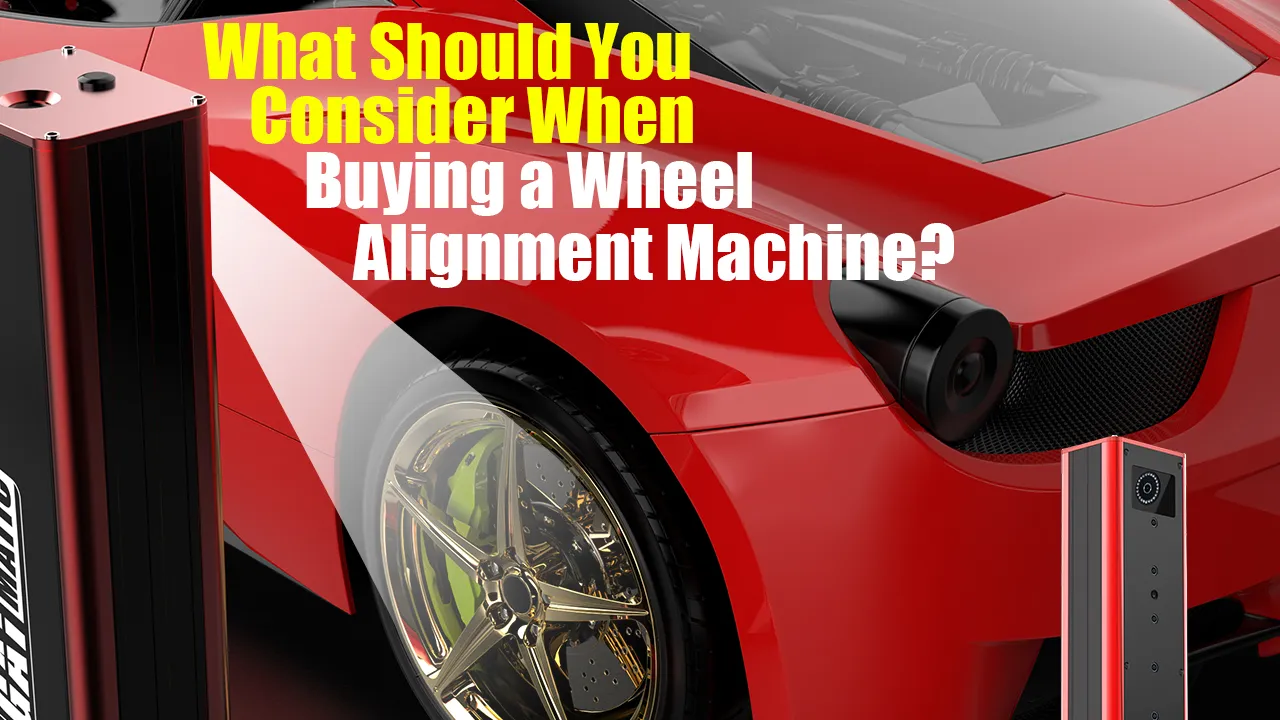What Should You Consider When Buying a Wheel Alignment Machine?
Introduction:
A wheel alignment machine is an essential tool for any auto repair shop or garage, especially when working on a wide range of vehicles. With Various models available, it can be difficult to determine which one will best suit your needs. The right wheel alignment can help improve service efficiency, increase accuracy, and boost customer satisfaction. To help you make an informed decision, here are the key factors to consider when buying a wheel alignment machine for your workshop.
What Type of Wheel Alignment Machine Do You Need?
When selecting a wheel aligner machine, it’s important to decide on the type of technology that best suits your workshop’s needs. There are three main types of alignment machines:
- 3D Wheel Alignment: These are highly advanced systems that use three-dimensional imaging technology to deliver precise measurements and ensure accurate alignments. They are ideal for high-end workshops or those servicing a wide variety of vehicles. 3D alignment machines offer real-time data and advanced diagnostics, making them perfect for larger, more complex operations.
- CCD Wheel Alignment: CCD systems use digital cameras to measure the angles of the wheels. They provide great precision and are suitable for workshops that focus on consumer vehicles or those that need a reliable, cost-effective option. While not as advanced as 3D systems, CCD alignment machines still offer excellent performance for most vehicle types.
- Touchless Wheel Alignment: This equipment use infrared technology to detect wheel angles without making physical contact with the wheels. They are especially beneficial for luxury or high-end vehicles, as they eliminate the risk of damaging the wheels during the alignment process. GATmatic GA-800 touchless alignment machines offer a high degree of accuracy and are a great option if you prioritize vehicle protection.
Choosing the right type of wheel alignment machine depends on the level of precision you require, the types of vehicles you service, and your budget. Consider whether your shop needs the cutting-edge capabilities of a touchless wheel alignment machine or if a more straightforward CCD or 3D wheel alignment system will meet your requirements.
Available Space for Installation
One of the most important factors to consider when evaluating the available space in your workshop is the available space. Wheel alignment machines come in two main configurations: mobile and fixed.
- Mobile wheel alignment machines: If you have limited space in your workshop, or you need the flexibility to move your machine around, a mobile wheel alignment machine is ideal. They are typically smaller, more compact, and have wheels for easy transportation.
- Fixed wheel alignment machines: These machines are typically larger and take up more space, but they are often more rugged, more accurate, and capable of handling heavy vehicles. Fixed wheel alignment machines are ideal for larger shops that specialize in high-volume alignment services.
Before purchasing, evaluate your shop layout and determine which type will maximize space efficiency and functionality.
Types of Vehicles You Service
The type of vehicles you commonly work on will determine the best wheel alignment machine for your needs.
- Passenger Cars: If your shop focuses on consumer vehicles, a standard 3D wheel alignment machine should suffice. These machines offer high precision and can handle the alignment needs of most cars.
- Heavy-Duty Trucks and Commercial Vehicles: If your shop works on larger vehicles like trucks or buses, consider investing in a more advanced system designed to accommodate heavier loads and larger tire sizes. These systems often have greater weight capacities and wider alignment ranges.
- Premium Vehicles: If your shop focuses on servicing luxury vehicles, such as sports cars. Non-contact wheel aligners are a great option for customers who do not want their wheels to be damaged during a wheel alignment. This machine uses infrared technology to detect wheel angles without making physical contact with the wheel.
Understanding your primary customer base helps you choose the appropriate equipment to serve them better and more efficiently.
Technician Training and Skill Level
Your technicians’ skills and training level play a big role in deciding what type of wheel alignment machine you should buy. Advanced models, such as 3D wheel alignment machine, offer more sophisticated features and greater accuracy, but may require a more experienced technician to operate effectively.
However, modern wheel alignment machines generally require little to no special skills to operate. Make sure the machine you choose matches your team’s technical capabilities. You may also want to consider training programs or other support offered by the manufacturer to help your staff get up to speed quickly.
Investment and ROI Expectations
Purchasing a wheel alignment machine is a significant investment, so it’s crucial to consider the potential return on investment (ROI). While advanced systems tend to come with higher upfront costs, they may offer greater accuracy, speed, and the ability to handle a wider range of vehicles.
- Cost vs. Benefits: A more affordable, 3D wheel alignment machine might meet your needs if your volume of wheel alignments is low. However, if your shop services high volumes or specializes in larger vehicles, the additional upfront cost of an advanced touchless wheel alignment machine might pay off through increased service efficiency and accuracy.
- Long-Term Savings: Consider the long-term savings in terms of time and accuracy. High-quality alignment systems often require less recalibration and fewer repairs, reducing overall maintenance costs.
Weigh the benefits of precision, faster turnaround times, and improved customer satisfaction against the initial investment.
Important Features for You and Your Technicians
Different wheel alignment machines come with a variety of features, so it’s essential to prioritize the ones that matter most to your workshop:
- Real-Time Diagnostics: Some systems offer real-time diagnostics and feedback, allowing your technicians to make adjustments during the alignment process. This feature can help improve the quality of service and reduce errors.
- Ease of Use: Look for machines with intuitive interfaces and easy-to-follow instructions. Machines that simplify the alignment process can reduce technician training time and increase the speed of service.
- Calibration and Maintenance: Machines with automatic calibration or self-diagnostic features reduce the time spent on maintenance and ensure consistent results.
- Vehicle Coverage: Choose a machine that offers flexible configurations to handle a variety of vehicle types and sizes. Some models come with adjustable turnplates, extended lifts, or other accessories designed to handle larger vehicles.
Choosing the right machine means selecting one that matches the needs of both your technicians and your customers.
Conclusion
When purchasing a wheel alignment machine, it’s important to consider the available space, the types of vehicles you service, the experience level of your technicians, your investment expectations, and the features that matter most to your shop. By taking these factors into account, you can make an informed decision that helps your business grow, enhances your service offerings, and ensures customer satisfaction.
GATmatic is a leading expert in automotive aftermarket solutions based in Shenzhen, China. Contact us now to invest in the right wheel alignment machine and improve your workshop’s productivity and reputation.
Describe Your Needs In Detail!
We will carefully evaluate your needs and give professional solutions.



